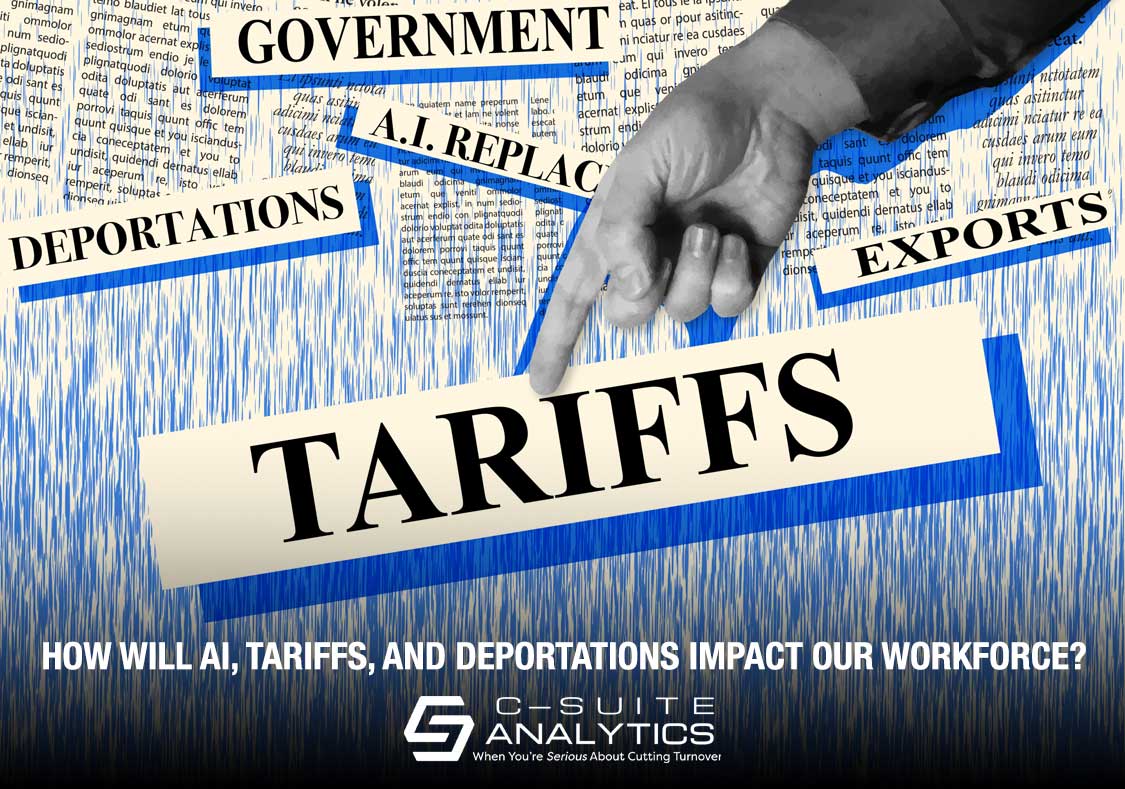AI, deportations, tariffs, and birthrate declines are reshaping America's workforce—blue- and white-collar alike. From baby boomer exits to AI disruptions, breaking down the workforce challenges no leader can afford to ignore.
Job Level Turnover, “The Great Resignation” Surprise

The common belief is that the employees quitting during “The Great Resignation” are young and don’t make much money, so replacing their meager incomes is just an uber-driving application away. Think of restaurant servers who thought their jobs were at least OK in 2019 but then had months to consider other options. When restaurants went back to full swing, these workers said “no” to working nights, weekends, and holidays. And the result is we wait in line outside our favorite restaurants while looking at empty tables that can’t be staffed.
“The Great Resignation” is not about young employees
While the above scenario is true, two new reports throw a heavy wrench into the assumption that “The Great Resignation” is only about young, lowly-paid employees.
AllVoices[i] surveyed 400 HR executives regarding their 2021 turnover and found this eye-opening distribution when asked which lob level had the most turnover:
- Mid-level 37.5%
- Senior level 34%
- Entry level 28.5%
Think about that. More than 70% of 400 HR executives said most turnover is NOT coming from entry-level workers. The study also tells us more than 80% of those who quit had been with their employers more than one year with the highest group being three to four years. So the cost of turnover from “The Great Resignation” just rocketed up.
The significance of the three-to-four-year mark is because other studies tell us millennials stay an average of two years and nine months. The oldest millennials turn 40 this year, so the data here implies the largest group of those who quit are also above 40.
Conclusion: The majority of workers we are losing during “The Great Resignation” are older, have more tenure with our companies, and are more likely to be in professional jobs than the commonly held belief that most of those who quit are entry-level workers.
“The Great Resignation” motivation is about more than pay
Very related, The Wall Street Journal reported on an Upwork study telling us more about professional freelance workers.[ii] That group is rapidly expanding with the carrots being more money, flexible hours, and control of the type and amount of work they perform. As one healthcare consultant said, “I’d be bored if you gave me a full-time job now”.
What are their greatest motivators? Eighty percent said control over schedule while 73% indicated location flexibility.
I’ve encountered this in my own family. My daughter Mackenzie, a teacher, became pregnant with her second child just prior to the pandemic. After consulting with her husband Chris, Mackenzie quickly calculated she could earn the same pay by tutoring two hours per day from home and not have to deal with the unknowns of pandemic issues in the school system. Her flexible schedule even allows her to take Julys and Decembers off if she choses. It was an easy call, and she plans to never teach in a classroom again.
“The Great Resignation” needs more than a one-size-fits-all approach
What does this mean for you? The common answers would be to implement flexible schedules and work from home policies, the trendy go-tos for to counter “The Great Resignation.” Oh, and raise pay, too, even though as reported here previously pay is the 16th highest reason why employees are currently quitting.
The problem with this approach is it’s one-size-fits-all, that it presumes you know precisely which types of schedule flexibility that each of your employees want. In the Wall Street Journal article referenced above, one new entrepreneur who recently left corporate America said his most important priority was taking his girls to soccer practice. You can’t build a policy around that…and it might not be important for that employee two years from now.
The real wake-up call here is “The Great Resignation” is affecting all levels and ages of workers, not just entry-level workers. To retain and engage your employees you will have to employee solutions that work for every level, every worker, and for years to come, even if “The Great Resignation” ends.
We’ve cut turnover and improved employee retention even during “The Great Resignation”
Just in the past year, our clients have saved over $2 million by implementing employee retention goals for managers and training them to conduct Stay Interviews the right way, which solves employee retention issues one at a time…all while building trust so turnover continues to decline. And those savings will grow and continue year after year.
Are your strategies for employee retention during “The Great Resignation” working?
It may be time to consider a different approach. Schedule a conversation with me at DFinnegan@C-SuiteAnalytics.com to discuss your plans, your roadblocks, how to move forward, and what is working for other companies to cut turnover by 20% and more, even during “The Great Resignation” that may benefit you.
[i] https://www.allvoices.co/blog/hr-and-the-great-resignation-whos-leaving-hiring-outlook-and-strategies-for-retention
[ii] https://www.wsj.com/articles/people-quit-full-time-jobs-for-contract-gigs-and-make-six-figures-great-resignation-11647291183?mod=newsviewer_click



